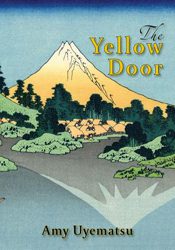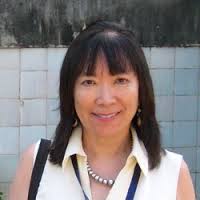
I was excited to review Amy Uyematsu’s The Yellow Door after being an enthusiastic fan of her third book, Stone Bow Prayer, from Copper Canyon in 2005. In this book, you will find the same talent with imagery and lyricism she displayed in Stone Bow Prayer, with a bit more bite—interwoven pop-cultural and historical themes revolve around prejudice and suffering, racism and stereotype. Could this book have come at a better time? When did we need an Asian-American woman speaking up about the writing and rights of Asian-American women more than after the Best American Poetry controversy surrounding a white man using a Chinese woman’s name (Yi-Fen Chou) to publish a poem? It seems like the right time to shine a light on actual women and actual Asian-Americans writing poetry.
As you might expect from the title, the main thematic exploration of the book is the color yellow, the way it figures in pop culture — such as pencils and happy faces — but also in hate speech towards Asian-Americans, as well as the way yellow was used in art by Van Gogh and Pissarro. Pop cultural and historical figures from Asian mail-order brides, prisoners of the Japanese internment camps of World War II, Fu Manchu, Bowie’s “China Girl” and others are interrogated for hidden meanings, like the way that insidious racism still works its way into mainstream American hipster store t-shirts. In “Haiku for the Unsuspecting Fortune Cookie Reader” she points out “Feng shui & sushi/ are American staples—/yellow skin is not”. She also touches on recent historical subject matter like the 2011 tsunami in Japan.
In subtler issues of class, gender, and race, in “Unpronounceable,” Uyematsu describes the difficulties she’s encountered as teachers and bureaucrats try to pronounce her last name, (a subject also tackled recently in Aimee Nezhukumatathil’s Miracle Fruit in the poem “My Name.”) In another poem looking at the history of words used to describe people of Asian American descent, “What’s In a Name,” Uyematsu charts the use of the word “oriental:”
“who lumped everything into the term—
from “Oriental” rugs and scrolls
to teacups, swords, and silk kimonos”
…“a label thrust on us from outsiders.”
Some of the most poignant poems in the book, including “The Sign Says ‘Closed for Business,’” “Thriftstore Haiku,” and “Gardening Shears,” describe the effects of horrible American WWII policies including Executive Order 9066, reclamation of property and relocation camps, on an older generation of Japanese Americans. In the poems she describes watching older men like her grandfather transformed from successful business men to talented gardeners in Southern California, after their businesses—and those of their Japanese friends – are confiscated or just disappear.
Uyematsu’s book displays her intelligence and functions as a primer for people interested in researching her artistic influences; she references multiple Asian-American writers in her work, including Cathy Song, Marilyn Chin, Lawson Inada, and Janice Mirikitani, as well as traditional Japanese artworks and songs. Two of my favorite poems from the book take advantage of this cultural layering, the long poem “Riding the Yellow Dragon” and the prose poem “The Return.”
In “Riding the Yellow Dragon, part iv.” she traces the heritage of dragons:
In ancient legend a Zen priest saw
a nine-headed dragon transform into
Kannion, the goddess of compassion.
Chinese dragons can fly, but those
from Japan have claws, not wings,
and inhabit the sea…
The woodblock masters found ways
to honor yellow dragons—
…My favorite is Kunisada’s
sea dragon with Buddha on its back.
In a much different weaving, “The Return” has an epigraph from N. Scott Momaday from “The Colors of Night” that describes “an old woman whose hair was long and black…She drew it around her like a shawl and so divided herself from the world that not even Age could find her.” In a beautiful surreal moment, exactly this sort of woman appears to the speaker in the middle of a jungle, on a bus where everyone else is asleep. This woman:
wears an unsashed kimono, carries a ceramic bowl containing water from a stream. She only visits when I am alone…I see her dancing under the light of the moon…Sometimes she rides on the hood of my car. Her hair streaming across the window, she keeps laughing. One August I find myself in a tropical jungle. All day the sun and rain and eyes of children follow me. That night I leave the jungle on a crowded bus; everyone is asleep but me. The only light comes from the headlights, a bare yellowish path through the black night, and a lucent white from the moon. The old woman is sitting beside me…asks me again ‘How strong is your love?’
To me, this poem exemplifies the type of thing Uyematsu does brilliantly in The Yellow Door—a marriage of freedom and grace, danger and beauty.
The Yellow Door continues Uyematsu’s tradition of strikingly crafted lyric poetry, this time combined with poems in a looser narrative style, as well as a more up-front confrontation of her experience of race as a third-generation Japanese-American poet, with her trademark humor and intellect shining through. A solid and satisfying read for fans and a great introduction to her work as well.





